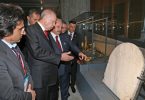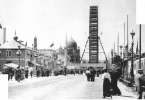Location: Istanbul Sultanahmet Horse Square. Date: June 1582. Ottoman Sultan Murad III is celebrating the circumcision of his son Mehmed. Just a little ahead the palace, right beside Hagia Sophia, at the city square, a forty days long celebration is taking place. Parades of trade guilds, entertainments, acrobats, bags of gold handed to people, gifts, food… It is a city festival because tradesmen who join the show to exhibit their talents are on the square again the next day as audience.
This was such a celebration that it was commemorated and celebrated after it ended! Mustafa Âli, a young and ambitious intellectual of the period wrote a 2772 couplet piece titled ‘Cami ul-Buhur der Mecalis-i Sur’ about these days, praised by poets with eulogies. This piece explains the celebrations in the palace as well as the events on the square, mentions actual circumcision ceremony, narrates the feasts to which high state officials attended. There is still a copy of ‘Cami ul-Buhur’ in Topkapı Palace however frames left empty for miniatures were never filled. But by the command of Ottoman Sultan Murad III, artists from painters’ house adorned the text of another poet, today known as İntizamî, with magnificent miniatures. The manuscript formed as a result is now famous 1582 ‘Surname’.
A scene is depicted in a picture of this manuscript: In the background Sultan is watching the yard from the pavilion on the upper floor of Ibrahim Pasha Palace with his son Prince Mehmed and two armorers from his entourage (in a way turning what happens into a manifestation of his own will and mercy by watching) and some Janissary put caftans on two people under Sultan’s very eyes; in the foreground stand five people, two with turbans and three Janissary with garments on their shoulders. This scene depicts two people being awarded with caftans. Ottomans did not grant medals and decorations until the early 19th century; either horses or valuable caftans called hıl’at were given as reward. Mustafa Âli’s text narrates the competition for this reward: Murad III would give each official in a group a fine horse with identical equipment. Sultan’s teacher, a prominent scholar and historian of his period Hodja Sa’d ed-Din was a very devout man and was not pleased with this. He said that governors should be regarded inferior to hodjas, and Sultan agreed to it.
The reflection of this kind of stories can be seen when picture is viewed. One of those rewarded with hil’at is a slave chamberlain that is a Janissary police with a very high rank, and other wears a turban, probably a scholar. Painting portrays sultan’s generosity as a balanced, even a righteous act. Garments drawn were of course not ordinary clothing. They had very long sleeves: these were utterly dysfunctional, decorative elements.
There is something else that is remarkable: Everybody in fact has similar attire, the only difference between attires is the head garments. And because the fabrics are valuable, hil’ats are dominantly in golden color; it is obvious that they are made up of brocaded heavy diba (silk fabric woven with silver and gold threads). The wealthy and dignitaries would wear fabrics mixed with silk and expensive furs, others never… It is difficult to distinguish from the pictures (because Prince Mehmed’s circumcision ceremony was celebrated in a summer month, furry garments were nowhere to be seen); however there is no “personal” style neither in uniforms nor individuals, except head garments.
It is disputable whether or not miniatures are realistic (and subject is still discussed by art historians); but the feeling that emerges is apparent: these garments worn “outside” in the Ottoman, went through an insignificant change for a long period of time and had a consistency because fashion played a minor role. In fact it was also the case for women because principally both men and women wore the same kind of clothing: Caftan over robe. The rest was secondary: shirt and pants or salwar under robes, shoes, belts, overcoats to throw on caftans… What distinguished women’s attire from men’s was veil: hijab element which made a woman invisible (and at the same time visible) on the outside. A world of motifs consistent within itself which was maintained for a long time, even centuries: stylized flowers, tulips, carnations, stars, “çintomani” inspired from Eastern Asia… These were not only used on fabrics but also on wood, tiles, ceramic containers and book bindings, and provided Ottoman aesthetics with a distinct consistency.
Country attire should be left out of this. Local clothes had a totally different world. Shepherd from Albania, merchant from Cairo and Bedouin from Mesopotamia would dress distinctly. Climate conditions, social circumstances would not allow anything else. However Ottoman dressing style in Istanbul, Edirne and the army is illustrated both in miniatures and gravures, oil paintings and drawing albums created in Latin Europe and it is a relatively conservative, long-winded, hardly personal style, not much influenced by fashion. In these depictions everyone’s position is apparent from headpieces and value and quality of the clothes worn but there is another peculiar commonality.
It would be really peculiar. However the situation we deduce from written sources like inheritance books and a few clothing items still around is more typical: Ali’s taste is not the same with Veli’s; what Ahmed Pasha preferred did not suit Osman Pasha’s liking. Individuals had color, fabric and form preferences: One would mainly dress in white and another in various colors. One would wear loose fit overcoats and oversized long tops over caftans, and others would prefer robes like frocks. One would spend money on heavy furs, other on brocaded silks with golden threads or fabric woven with silver and gold. And maybe personal preferences played a minimal role in the most expensive clothing items: Hıl’ats would pass from hand to hand, shoulder to shoulder, even would return to the palace after a long journey through confiscations to be re-utilized: Valuable fabrics were never disposed of.
This way can be seen in Ottoman attire universe at least three layers: Ali and Veli had quite personal tastes and actually manifested in their dressing style. However the piece of garment worn over head would reveal their social class and the quality of their clothes would more or less suit their social statuses. In conclusion everybody would move around in a clothing universe imaginary yet with extremely influential outlines and with consistency. This was the class always depicted.
This universe came to an end with modernity. First, Mahmud II (1803-39) obliged soldiers and principal registry officers to wear fez, and then Muslimnon-Muslim townsmen started to wear fez as a mark of being Ottoman. Later uniforms worn by Sultan and officials, trousers and jackets called Istanbulî which became the symbol of those without uniforms, Latin European style dresses exclusively for women and the concept of fashion changing every year alongside, put an end to modern age Ottoman attire universe, at least to an extent in the 19th century. Ottoman modernity which was in contact with Europe but developed in its own way brought along an attire reform. Reforms regarding this in Turkish Republic were to be realized later on as part of this modernity.









Leave a Comment